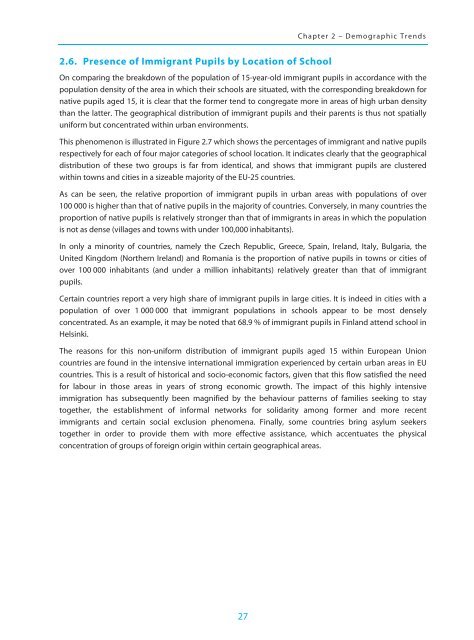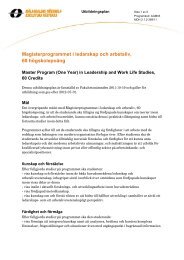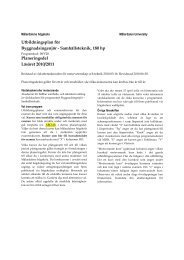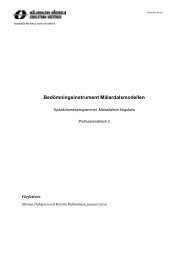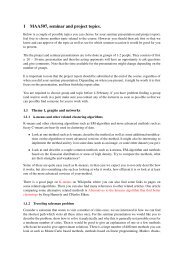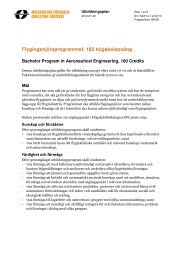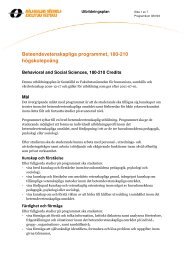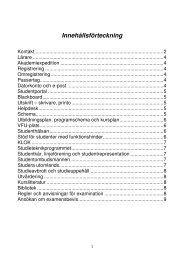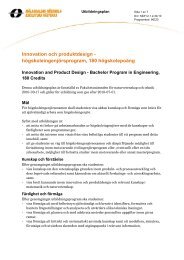Integrating Immigrant Children into Schools in Europe
Integrating Immigrant Children into Schools in Europe
Integrating Immigrant Children into Schools in Europe
You also want an ePaper? Increase the reach of your titles
YUMPU automatically turns print PDFs into web optimized ePapers that Google loves.
Chapter 2 – Demographic Trends2.6. Presence of <strong>Immigrant</strong> Pupils by Location of SchoolOn compar<strong>in</strong>g the breakdown of the population of 15-year-old immigrant pupils <strong>in</strong> accordance with thepopulation density of the area <strong>in</strong> which their schools are situated, with the correspond<strong>in</strong>g breakdown fornative pupils aged 15, it is clear that the former tend to congregate more <strong>in</strong> areas of high urban densitythan the latter. The geographical distribution of immigrant pupils and their parents is thus not spatiallyuniform but concentrated with<strong>in</strong> urban environments.This phenomenon is illustrated <strong>in</strong> Figure 2.7 which shows the percentages of immigrant and native pupilsrespectively for each of four major categories of school location. It <strong>in</strong>dicates clearly that the geographicaldistribution of these two groups is far from identical, and shows that immigrant pupils are clusteredwith<strong>in</strong> towns and cities <strong>in</strong> a sizeable majority of the EU-25 countries.As can be seen, the relative proportion of immigrant pupils <strong>in</strong> urban areas with populations of over100 000 is higher than that of native pupils <strong>in</strong> the majority of countries. Conversely, <strong>in</strong> many countries theproportion of native pupils is relatively stronger than that of immigrants <strong>in</strong> areas <strong>in</strong> which the populationis not as dense (villages and towns with under 100,000 <strong>in</strong>habitants).In only a m<strong>in</strong>ority of countries, namely the Czech Republic, Greece, Spa<strong>in</strong>, Ireland, Italy, Bulgaria, theUnited K<strong>in</strong>gdom (Northern Ireland) and Romania is the proportion of native pupils <strong>in</strong> towns or cities ofover 100 000 <strong>in</strong>habitants (and under a million <strong>in</strong>habitants) relatively greater than that of immigrantpupils.Certa<strong>in</strong> countries report a very high share of immigrant pupils <strong>in</strong> large cities. It is <strong>in</strong>deed <strong>in</strong> cities with apopulation of over 1 000 000 that immigrant populations <strong>in</strong> schools appear to be most denselyconcentrated. As an example, it may be noted that 68.9 % of immigrant pupils <strong>in</strong> F<strong>in</strong>land attend school <strong>in</strong>Hels<strong>in</strong>ki.The reasons for this non-uniform distribution of immigrant pupils aged 15 with<strong>in</strong> <strong>Europe</strong>an Unioncountries are found <strong>in</strong> the <strong>in</strong>tensive <strong>in</strong>ternational immigration experienced by certa<strong>in</strong> urban areas <strong>in</strong> EUcountries. This is a result of historical and socio-economic factors, given that this flow satisfied the needfor labour <strong>in</strong> those areas <strong>in</strong> years of strong economic growth. The impact of this highly <strong>in</strong>tensiveimmigration has subsequently been magnified by the behaviour patterns of families seek<strong>in</strong>g to staytogether, the establishment of <strong>in</strong>formal networks for solidarity among former and more recentimmigrants and certa<strong>in</strong> social exclusion phenomena. F<strong>in</strong>ally, some countries br<strong>in</strong>g asylum seekerstogether <strong>in</strong> order to provide them with more effective assistance, which accentuates the physicalconcentration of groups of foreign orig<strong>in</strong> with<strong>in</strong> certa<strong>in</strong> geographical areas.27


